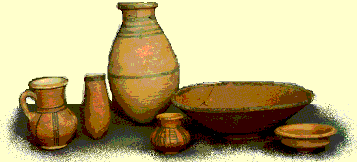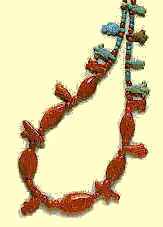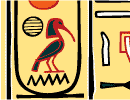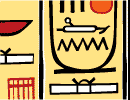Daily Life

 To understand
the everyday life of ancient Egyptians, archaeologists draw on many
sources. The most valuable sources include tomb paintings, reliefs,
and the objects included in tombs that the Egyptians used in their daily
life. Artifacts from the few towns that have been excavated and hundreds
of documents written by the ancient Egyptians shed additional light on
their life. Much of the day-to-day running of their households, however,
remains obscure. To understand
the everyday life of ancient Egyptians, archaeologists draw on many
sources. The most valuable sources include tomb paintings, reliefs,
and the objects included in tombs that the Egyptians used in their daily
life. Artifacts from the few towns that have been excavated and hundreds
of documents written by the ancient Egyptians shed additional light on
their life. Much of the day-to-day running of their households, however,
remains obscure.
The nuclear family was the fundamental social unit of ancient
Egypt. The father was responsible for the economic well-being of the
family, and the mother supervised the household and cared for the
upbringing of the children. Although Egyptian children
had toys and are occasionally depicted at play, much of their time was
spent preparing for adulthood. For example, peasant children accompanied
their parents into the fields; the male offspring of craftsmen often
served as apprentices to their fathers. Privileged children sometimes
received formal education to become scribes or
army officers.
 The few furnishings in the
ancient Egyptian home were simple in design. The most common piece of
furniture was a low stool, used by all Egyptians including the pharaoh.
These stools were made from wood, had leather or woven rush seats, and had
three or four legs. Most kitchens were equipped with a cylindrical, baked
clay stove for cooking. Food was stored
in wheel-made
pottery. The basic cooking equipment was a two-handled pottery saucepan. The few furnishings in the
ancient Egyptian home were simple in design. The most common piece of
furniture was a low stool, used by all Egyptians including the pharaoh.
These stools were made from wood, had leather or woven rush seats, and had
three or four legs. Most kitchens were equipped with a cylindrical, baked
clay stove for cooking. Food was stored
in wheel-made
pottery. The basic cooking equipment was a two-handled pottery saucepan.
 The ancient Egyptians embellished their
usually plain clothing with elaborate costume jewelry. Both men and
women wore jewelry such as earrings, bracelets, anklets, rings, and beaded
necklaces. They incorporated into their jewelry many minerals
including amethyst, garnet, jasper, onyx, turquoise, and lapis lazuli, as
well as copper, gold, and shells. Because the Egyptians were very
superstitious, frequently their jewelry contained good luck charms called
amulets. The ancient Egyptians embellished their
usually plain clothing with elaborate costume jewelry. Both men and
women wore jewelry such as earrings, bracelets, anklets, rings, and beaded
necklaces. They incorporated into their jewelry many minerals
including amethyst, garnet, jasper, onyx, turquoise, and lapis lazuli, as
well as copper, gold, and shells. Because the Egyptians were very
superstitious, frequently their jewelry contained good luck charms called
amulets.
 Cosmetics were not only an important part of Egyptian
dress but also a matter of personal hygiene and health. Many items
related to cosmetics have been found in tombs and are illustrated in tomb
paintings. Oils and creams were of vital importance against the hot
Egyptian sun and dry winds. Eye paint, both green and black, is probably
the most characteristic of the Egyptian cosmetics. The green pigment,
malachite, was made from copper. The black paint, called kohl, was made
from lead or soot. Kohl was usually kept in a small pot
that had a flat bottom, wide rim, tiny mouth, and a flat, disk-shaped lid.
Cosmetics were not only an important part of Egyptian
dress but also a matter of personal hygiene and health. Many items
related to cosmetics have been found in tombs and are illustrated in tomb
paintings. Oils and creams were of vital importance against the hot
Egyptian sun and dry winds. Eye paint, both green and black, is probably
the most characteristic of the Egyptian cosmetics. The green pigment,
malachite, was made from copper. The black paint, called kohl, was made
from lead or soot. Kohl was usually kept in a small pot
that had a flat bottom, wide rim, tiny mouth, and a flat, disk-shaped lid.


|





